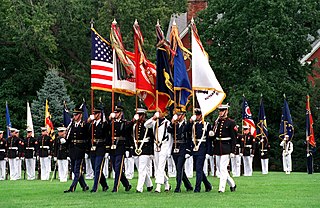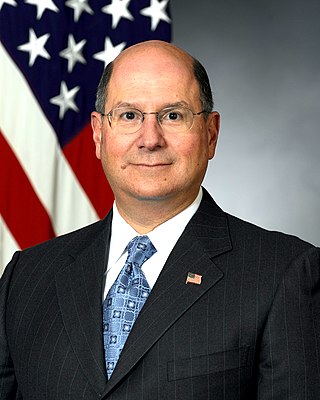Related Research Articles
The United States Armed Forces are the military forces of the United States. The armed forces consist of six service branches: the Army, Marine Corps, Navy, Air Force, Space Force, and Coast Guard. All six armed services are among the eight uniformed services of the United States.

The National Security Act of 1947 was a law enacting major restructuring of the United States government's military and intelligence agencies following World War II. The majority of the provisions of the act took effect on September 18, 1947, the day after the Senate confirmed James Forrestal as the first secretary of defense.
Vice admiral is a senior naval flag officer rank, usually equivalent to lieutenant general and air marshal. A vice admiral is typically senior to a rear admiral and junior to an admiral.

The Joint Chiefs of Staff (JCS) is the body of the most senior uniformed leaders within the United States Department of Defense, which advises the president of the United States, the secretary of defense, the Homeland Security Council and the National Security Council on military matters. The composition of the Joint Chiefs of Staff is defined by statute and consists of a chairman (CJCS), a vice chairman (VJCS), the chiefs of the Army, Marine Corps, Navy, Air Force, Space Force, and the chief of the National Guard Bureau. Each of the individual service chiefs, outside their JCS obligations, works directly under the secretaries of their respective military departments, e.g. the secretary of the Army, the secretary of the Navy, and the secretary of the Air Force.

The several branches of the United States Armed Forces are represented by flags. Within the U.S. military, various flags fly on various occasions, and on various ships, bases, camps, and military academies.

The Naval War College is the staff college and "Home of Thought" for the United States Navy at Naval Station Newport in Newport, Rhode Island. The NWC educates and develops leaders, supports defining the future Navy and associated roles and missions, supports combat readiness, and strengthens global maritime partnerships.

The Goldwater–Nichols Department of Defense Reorganization Act of October 4, 1986 made the most sweeping changes to the United States Department of Defense since the department was established in the National Security Act of 1947 by reworking the command structure of the U.S. military. It increased the powers of the chairman of the Joint Chiefs of Staff and implemented some of the suggestions from the Packard Commission, commissioned by President Reagan in 1985. Among other changes, Goldwater–Nichols streamlined the military chain of command, which now runs from the president through the secretary of defense directly to combatant commanders, bypassing the service chiefs. The service chiefs were assigned to an advisory role to the president and the secretary of defense, and given the responsibility for training and equipping personnel for the unified combatant commands.

The United States Naval Criminal Investigative Service (NCIS) is the primary investigative law enforcement agency of the U.S. Department of the Navy. Its primary function is to investigate major criminal activities involving the Navy and Marine Corps, though its broad mandate includes national security, counterintelligence, counterterrorism, cyberwarfare, and the protection of U.S. naval assets worldwide. NCIS is the successor organization to the former Naval Investigative Service (NIS), which was established by the Office of Naval Intelligence after the Second World War.
Counter admiral is a rank found in many navies of the world, but no longer used in English-speaking countries, where the equivalent rank is rear admiral. The term derives from the French contre-amiral. Depending on the country, it is either a one-star or two-star rank.

The Dental Corps of the United States Navy consists of naval officers with a doctorate in either dental surgery (DDS) or dental medicine (DMD) and who practice dentistry for Sailors and Marines to ensure optimal oral health.

The Office of Naval Research (ONR) is an organization within the United States Department of the Navy responsible for the science and technology programs of the U.S. Navy and Marine Corps. Established by Congress in 1946, its mission is to plan, foster, and encourage scientific research to maintain future naval power and preserve national security. It carries this out through funding and collaboration with schools, universities, government laboratories, nonprofit organizations, and for-profit organizations, and overseeing the Naval Research Laboratory, the corporate research laboratory for the Navy and Marine Corps. NRL conducts a broad program of scientific research, technology and advanced development.

Donald Charles Winter is an American technologist and business leader who served as United States Secretary of the Navy. A former top executive of TRW, Aerospace & Defense, he was nominated in 2005 by President George W. Bush, confirmed by the United States Senate, and took the oath of office on January 3, 2006. In January 2009 Defense Secretary Robert Gates requested that Winter remain in office until President Obama picked his successor on March 13, 2009. He resigned on March 13.

Albert Thomas Church III is a retired vice admiral in the United States Navy. Church served as on active duty for 36 years, retiring as a vice admiral in 2005. During his service he commanded two warships, the Navy's largest shore installation at Naval Station Norfolk, Virginia, and was the longest-serving budget director of the Navy (1998–2002). Church also served as the Naval Inspector General, during which time he completed a comprehensive review of interrogation techniques used by the Department of Defense in Iraq, Afghanistan, and at Guantanamo Bay, Cuba. He is currently president of Prescient Edge Corporation, a US-based national security services and technology Firm.

The United States Department of Defense is an executive branch department of the federal government of the United States charged with coordinating and supervising all agencies and functions of the U.S. government directly related to national security and the United States Armed Forces. As of June 2022, the U.S. Department of Defense is the largest employer in the world, with over 1.34 million active-duty service members, including soldiers, marines, sailors, airmen, and guardians. The Department of Defense also maintains over 778,000 National Guard and reservists, and over 747,000 civilians bringing the total to over 2.87 million employees. Headquartered at the Pentagon in Arlington County, Virginia, just outside Washington, D.C., the Department of Defense's stated mission is to provide "the military forces needed to deter war and ensure our nation's security".
Dylan Schmorrow is an American scientist and retired United States Defense Official. He is currently the chief scientist at Soar Technology, Inc.. He is a retired US Navy captain, and served as the deputy director of the Human Performance, Training, and BioSystems Research Directorate at the Office of the Assistant Secretary of Defense, Research & Engineering at Office of the Secretary of Defense. He was also specialty leader of the Aerospace Experimental Psychologist community and an acquisition professional in the Naval Acquisition Corps.

The Operational Test and Evaluation Force (OPTEVFOR) is an independent and objective agency within the United States Navy for the operational testing and evaluation (OT&E) of naval aviation, surface warfare, submarine warfare, C4I, cryptologic, and space systems in support Navy and Department of Defense acquisition programs.

The United States Department of Defense is one of the largest single consumers of energy in the world, responsible for 93% of all US government fuel consumption in 2007 (Air Force: 52%; Navy: 33%; Army: 7%. Other DoD: 1%). In FY 2006, the DoD used almost 30,000 gigawatt hours (GWH) of electricity, at a cost of almost $2.2 billion. The DoD's electricity use would supply enough electricity to power more than 2.3 million average American homes. In electricity consumption, if it were a country, the DoD would rank 58th in the world, using slightly less than Denmark and slightly more than Syria (CIA World Factbook, 2006). The Department of Defense uses 4,600,000,000 US gallons (1.7×1010 L) of fuel annually, an average of 12,600,000 US gallons (48,000,000 L) of fuel per day. A large Army division may use about 6,000 US gallons (23,000 L) per day. According to the 2005 CIA World Factbook, if it were a country, the DoD would rank 34th in the world in average daily oil use, coming in just behind Iraq and just ahead of Sweden.

CNA, formerly known as the CNA Corporation, is a federally-funded nonprofit research and analysis organization based in Arlington County, Virginia. It has around 625 employees.

Dennis Vincent McGinn is a former American government official and retired United States Navy admiral. He served as Assistant Secretary of the Navy for Energy, Installations and Environment in the Obama administration from 2013 to 2017. A career naval aviator, McGinn was an officer in the United States Navy for 35 years, retiring as a vice admiral.
References
- 1 2 Aftergood, Steven (April 5, 2019). "Navy Torpedoes Scientific Advisory Group". Federation Of American Scientists. Retrieved 2020-07-15.
- ↑ Leo Rosten, ed. (1975). Religions of America: Ferment and Faith in an Age of Crisis: A New Guide and Almanac. New York: Simon and Schuster. p. 296. ISBN 0-671-21970-7. OCLC 1093360.
- ↑ "10 U.S. Code § 8024 - Naval Research Advisory Committee". LII / Legal Information Institute. Retrieved 2020-07-15.
- ↑ "Naval Research Advisory Committee Report Distributed Operations" (PDF). navy.mil. July 2006. Archived from the original (PDF) on 2012-09-14. Retrieved 2020-07-15.
- ↑ Navy.mil [ dead link ]
- ↑ "Naval Research Advisory Committee Report Future Fuels" (PDF). April 2006. Archived from the original (PDF) on 2006-08-19.
- ↑ "50 Years in Space - Frank Fernandez". www.galcit.caltech.edu. July 26, 2007. Retrieved 2020-07-15.
- ↑ Siegel, Aaron T. (March 29, 2019). "Termination of the Secretary of the Navy Advisory Panel". Federal Register . 84 (61): 11936.
- ↑ Modly, Thomas B. (21 Feb 2019). "MEMORANDUM FOR THE DEPUTY UNDER SECRETARY OF THE NAVY SUBJECT: Disestablishment of the Secretary of the Navy Advisory Panel and Naval Research Advisory Sub-Committee" (PDF). Federation of American Scientists .